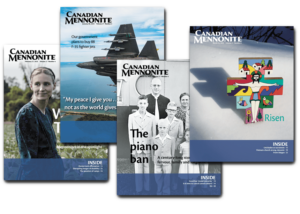For the past three years, the United States has been my home, and in the U.S., division is impossible to ignore. Liberals on the left, conservatives on the right. Of course, Canada is not immune to these divisions, and neither is the church.
In this context, what hope does the church have of discerning the movement of God’s Spirit? Apart from conservative and liberal, what options does the church have for recognizing the possibilities that emerge through our differences?
As I’ve looked for alternatives to line-in-the-sand divisions, I’ve found the biblical language of “binding” and “loosing” helpful.
In Jewish law, binding is the practice of moral discernment as communities negotiate their identity and define their boundaries. To loose is to free from obligation. A community practices loosing as it listens to new voices and allows its boundaries to shift.
One of the challenges in the Mennonite church, as noted by Chris Huebner, professor at Canadian Mennonite University, is that “some congregations are dedicated practitioners of binding, while others are experts at loosing. Vary rarely does one find both in one place.”
Both conservative and liberal individuals and congregations can be experts at binding. For example, conservative congregations have urged church leadership to maintain a definitive commitment to Scripture and The Confession of Faith in a Mennonite Perspective on questions of sexuality. Liberal churches have urged change. In both cases, I’ve wondered if churches across the spectrum share the goal of creating or maintaining definitive boundaries for Mennonite theological identity.
This temptation to bind is also a temptation to divide. Binding to a definitive understanding of Mennonite identity reinforces a view that unity is based on agreement. Those who disagree with the boundaries are pushed to leave and/or choose to leave the larger church.
The practice of loosing, in contrast, is more comfortable with ambiguous boundaries. Mennonite Church Canada has taken this approach in efforts to “create space” for congregations to “test alternative understandings” and follow the “nudging of the Spirit of God.”
For me, the offering of this spaciousness brings some relief. At the same time, I recognize this loosing comes with its own danger. The temptation is to avoid conversations that engage difference. Instead, each congregation is encouraged to engage in ways that make sense for them, while allowing others to do the same.
This sort of tolerance comes with loss. By avoiding conversations that engage with difference, we lose the opportunities to learn from others who hold positions unlike our own.
When I imagine the sort of church I want to be part of, I imagine an ever-expanding community of people who are willing to practice binding and loosing.
What does this look like?
I think of my grandma, who, for the past 10 years, has faithfully emailed me every morning, except Sundays, with a verse of scripture. The emails always conclude with, “My love and prayers.” I suspect she and I read many of these scriptures differently, but interpretation is not what matters here. Rather, her emails invite me to bind myself to the faith tradition that reminds me that I am beloved and created by God.
When we are together, Grandma leans in, asking me questions about what I’m learning. As I speak, she creates space to receive my experience of faith, even when it differs from hers. My hope is that I also cultivate the ability to lean in to hear what is sacred in her experience.
When I think of the movement between binding and loosing, I see glimmers and moments that point to God’s expansive goodness in community. When we believe that we have a definitive grasp on what is good, right and true, it’s likely that the boundaries have become too rigid.
Where the boundaries become rigid, we risk losing the creativity and energy at the edges of what we understand.
I like to think the church might be best characterized by a patient struggle to become attentive to the tensions, conflicts and glimmers that emerge in attempts to meet others at the edges of difference. In the political realm, unity is increasingly illusive. In the context of the church, however, we are instructed in our scriptures to strive for unity. In looking for glimmers of connection, I want to refuse the temptation to give up.
Where do you see glimmers of connection across difference?
Anika Reynar works in Boston as a facilitator and mediator in environmental disputes.
Tethered by Ryan Dueck
I was so pleased to see Anika’s reference to her grandmother’s emails. My grandmother was also in the habit of emailing her entire family every day. She would include observations on the news, family updates, dates of significance (birthdays, anniversaries, etc.), Bible verses, even the occasional punchy exhortation.
Sometimes they were several paragraphs, sometimes only a sentence or two. Like Anika, I didn’t see everything the same as my grandmother, but these little notes had the effect of binding me to a story that was broader and deeper and stronger than just my own.
My grandmother has been gone for several years. I miss her emails, not just for the reminders, updates and connections, but also because she kept us tethered to a particular way of inhabiting faith and of living in the world. Her faith wasn’t perfect (none of ours is!), but it was strong, durable, resilient and joyful, often in the face of difficulties that I could barely imagine.
When I was younger, I sometimes found myself thinking, “Oh Grandma, you may not be as right as you think on that one.” As the years went by, it increasingly became, “Oh Ryan, your grandmother might have more to teach you than you think.”
Ryan Dueck, pastor at Lethbridge (Alberta) Mennonite Church
Glimmer by Cindy Wallace
At the height of the pandemic, one of my dear friends became convinced that vaccines were a means of government control and did enormous damage to our bodies. By contrast, I understood (and understand) vaccines, not as a panacea, but as a calculated risk we take for the common good. The public conversation in 2022 was profoundly polarized, but this friend and I managed to have several frank discussions rooted in our shared faith and mutual love. These conversations were a gift, showing me how unity could be interwoven with attention to conflict and difference. It was a glimmer of connection across difference.
In many ways, I have found that relationship more reassuring than friendships where we shy away from discussing the tensions we suspect exist between us.
Of course, not every moment or relationship requires us to excavate the depths of our differences, but to build true and fulsome unity—in friendship, in marriage, in community, and certainly in church—we need to tell each other the truth of where our hearts and minds both converge and diverge.
This way of loving and knowing each other is hard and countercultural, but, in my experience, it is also profoundly life-giving.
Cindy Wallace, professor of English at St. Thomas More College at the University of Saskatchewan
History by Justin Sun
“What options does the church have for recognizing the possibilities that emerge through our differences?” This insightful question from Anika is one I believe all Christians must ask of ourselves and our communities.
It is also a question Christians can ask of history.
My mind goes to the US civil rights movement—(Christian) segregationists fighting against Black rights and personhood. Or the Stonewall riots— the culmination of decades of violence against gay people in New York, supported by Christians. There are the anti-war protests of the early 2000s— divisive in churches even among those who, like me, barely remember it.
In these moments, something was asked of people with differences, including many in churches. Who would they be in the face of racism, homophobia, or war? Who or what would they unite with, and how? What could come from deep division?
If the church is to be characterized by patient struggle with difference for the sake of the other, may it also learn to recognize the movement of God’s Spirit to break the roots of division and idealized uniformity and instead to grow toward a real, expansive goodness for all.
Justin Sun, youth pastor at Peace Mennonite Church, Richmond, B.C.









Leave a Reply
You must be logged in to post a comment.